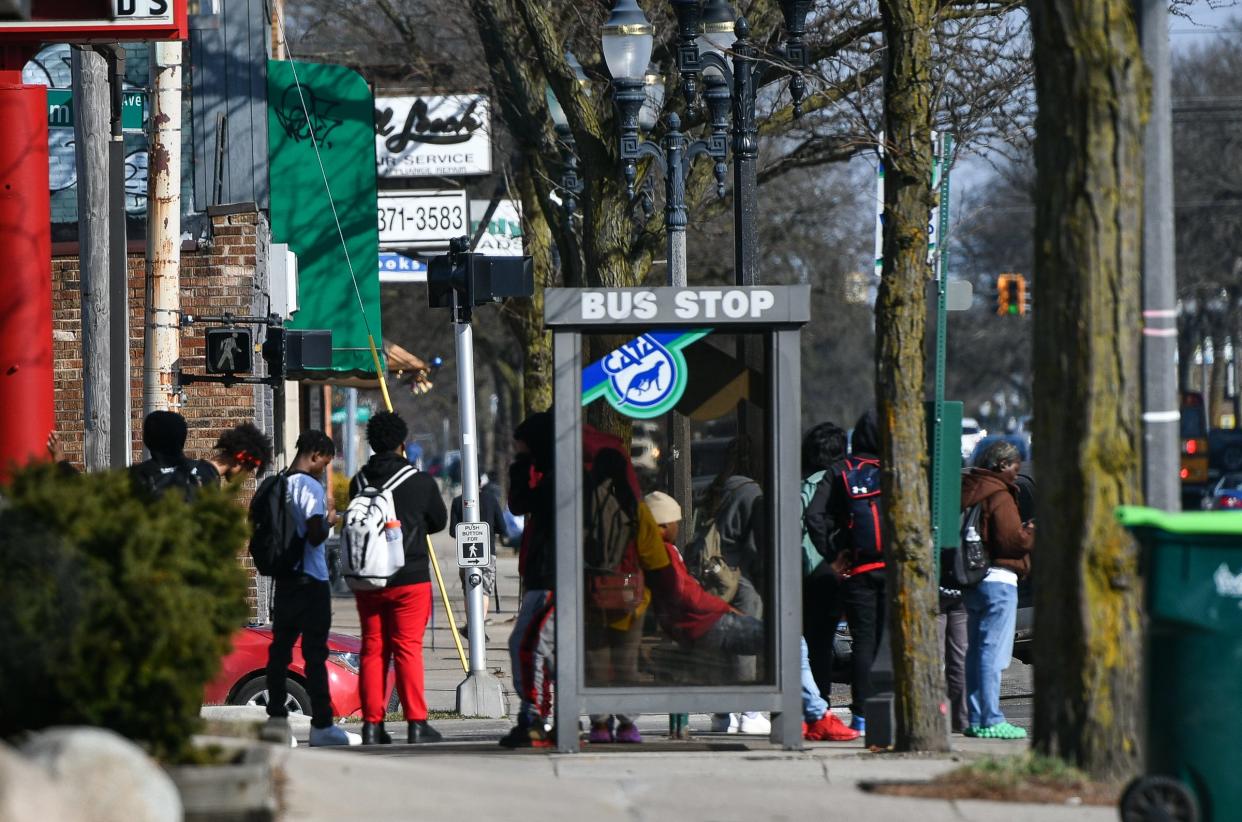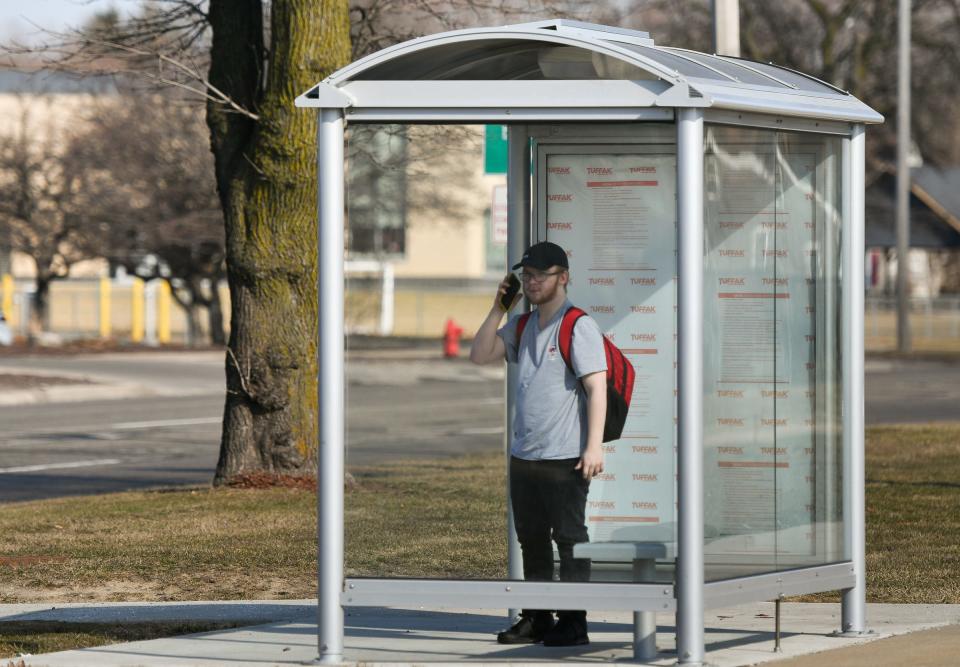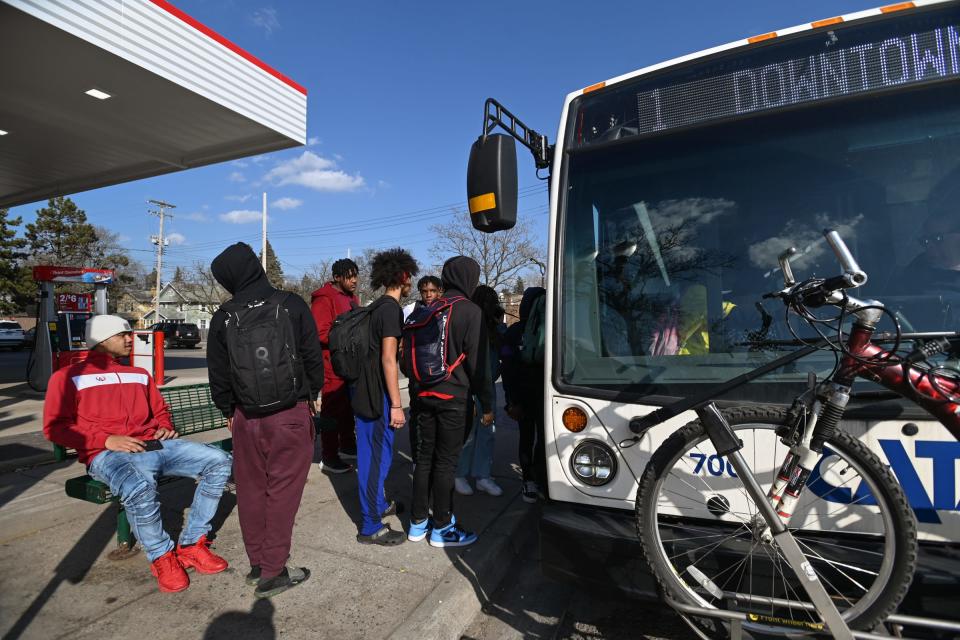Why Lansing schools' once-controversial move to CATA buses is increasingly popular

LANSING — Charlene Thomas has two children attending Lansing high schools, and the district’s decision in August of 2022 to eliminate traditional busing for nearly 3,300 high school students was slightly unnerving.
More than a year later, her son Braeden Lewis and her daughter Channing Lewis have free passes provided by the Lansing School District to get to Sexton and Everett high schools, respectively.
"I was nervous at first," Thomas said. "At the time, I was working a job where if they missed the bus or something happened, they wouldn't be able to get a hold of me."
Superintendent Ben Shuldiner announced before the 2022-23 school year that the district would no longer use Dean Transportation to get high school students to school. The bus company had lost nearly half of its employees after the pandemic, and the loss meant that some routes no longer had drivers.
High school students and their families were given a choice — a free bus pass for Lansing's Capital Area Transportation Authority or a $50 monthly gas card.
Plenty of parents shared Thomas’ concerns, but data shows that 18 months later, many of those concerns have been alleviated.
Early on, only about 300 students chose the bus pass, a lower number than the district expected, said Kristina Tokar, the district's chief operating officer. Nearly 3,000 chose gas cards.
Today, 753 students ride the CATA buses. More than 2,600 other students receive monthly gas cards. While the ridership numbers are still short of Shuldiner’s goal of 1,000 students, the program hasn’t cost the district anymore than traditional buses and attendance at the district’s three high schools is up dramatically.
"I don't think it's any more dangerous than riding a yellow school bus," Thomas said.
'It's kinda convenient'

When the district's plans were announced, parents initially expressed concerns about their children riding the bus with strangers. The district told parents there would be school safety officers at the downtown CATA Transportation Center and adults were volunteering to ride the buses with students to make sure they got where they needed to be.
The district said that since implementing the program, few parents have complained about it, and more parents are realizing the bus is a safe and convenient option.
"Any time there's change, people have objections," Tokar said. "But I'm happy to say that those concerns became less and less as time went on and parents saw that their kids were getting to school safely."
Shuldiner said he's heard from students that they appreciate having the independence the bus passes provide.
Lebron Stitt, who attends Sexton High School, is one of those students. He has been able to access new opportunities with the bus pass.
"It's kinda convenient. I can go to work on the CATA bus, go to school, go to my friends'..." he said.
Lebron works at Firehouse Subs in downtown Lansing, and it's a seven-minute walk from the bus station at 420 Grand Ave. in downtown Lansing to work on Washington Avenue. He doesn't need to rely on his mom for rides, which he thinks is helpful for her.
Channing said she likes having the independence to make her own choices and be responsible for getting herself where she needs to be, when she needs to be.
"It's easy. I know how to use the app and look at the routes so I know where I'm going," Channing said. "And I can see, you know, if I have to be somewhere at a certain time I know what bus I need to take to get there on time."
Safety concerns don't materialize

Ja'Veaha Mays, another Sexton High School student, said she was a little wary about taking the bus, but said there's been no problems.
"I think it's been fine overall..." she said. "My parents did tell me to always be aware of my surroundings and know where I am."
Thomas said her children were "very nervous" to take the bus.
"We did a few sample runs where we rode the route they'd be taking together," Thomas said. "And we talked about what to do if you miss a stop, where the next one is. We learned how to use the app together."
Thomas said her daughter has mentioned a few concerning incidents taking place at Everett's bus stop, located about a block away from the school.
"I've noticed a security car there the last few times I've been there to pick my daughter up," she said. "I think as more kids are taking the bus, the more chance they'll be unattended. But I know they have security and people watching the kids, and I don't think this has anything to do with them taking city buses. It's a problem with the kids doing stuff like this."
Thomas said her only concern today is the amount of time it takes for Channing to get to school riding the CATA bus versus riding the school bus. She said her daughter gets picked up about 6:28 a.m. and gets to school about 90 minutes later at 8 a.m.
"So, you know, that's a lot of her day spent on the bus," Thomas said.
A win for the district and CATA
Coming off the pandemic, CATA needed riders, and Shuldiner needed a way to ensure students got to school. In other city-based school districts, students ride public transportation and he didn't see any reason why it couldn't work in Lansing.
According to Lolo Robison, CATA's public information officer, ridership had plummeted more than 70% to about 3 million rides in 2021, compared to 11 million taken by the Lansing community in 2019. It was rebounding in the fall of 2022, when the collaboration between the school district and CATA began, but ridership for that year remained a little less than 5.5 million.
"We saw the ridership decrease, so when the school district reached out we were interested." she said.
"Our bottom line is to relieve the transportation barrier," Robison said. "We work really hard to do accommodate what the district needs."
That included extending bus routes and having extra buses available in case an influx of students need rides.
"We wanted to get this right, and do right by the students," she said.
Parents of students taking the CATA bus can also get free bus passes from the district. Shuldiner said the district wanted to have an option for parents who were worried about students taking the bus by themselves, or even parents who need a secure transportation method.
In August 2022, Shuldiner said that he expected the cost of the cards to be about the same amount and possibly less than the cost to have Dean Transportation shuttle high school students to and from school. At the time, Shuldiner said there was a possibility that savings could run up to $100,000, with all of the savings going back to support busing.
Transportation costs have risen in the last few years, according to budget data from the school district. In the 2021-22 school year, Lansing spent over $9 million on pupil transportation for all of its schools. In the 2022-23 school year, the first year the district used the CATA buses for high schoolers, costs went up by about $1 million. For the 2023-24 school year, $9.5 million has been budgeted for student transportation; exact expenditures are not yet available.
The district did not provide information on gas card expenditures, but if the more than 2,600 students are receiving $50 gas cards monthly, the costs would be about $1.2 million for nine months for the district. The district pays $100 per annual CATA pass per student or family member.
Improving attendance rates
Shuldiner and Tokar attribute the high schools' rising attendance rates, in part, to the transportation options.
Average attendance for the three high schools was about 66% for the 2021-2022 school year. The next year, when the bus passes and gas cards were implemented, average attendance was about 75%. Attendance data is not yet available for the current school year.
The district has also seen an increase in the number of students who attend after-school programs, such as tutoring and sports. The CATA buses leave periodically so students can stay after school without having to worry about getting a ride back home, like they might if a traditional school bus is their only option.
The district has no plans to pivot from using the gas cards and bus passes. Instead, officials anticipate more and more students seeing the benefit of using the bus passes.
"The school district's job is to help educate children, but we also know our role is much more than that," Shuldiner said. "There's no reason why we can't think that the money that we get to fund schools can also be a way to help support our families.
"And so if the money is for transportation, why not instead of giving it to a bus company, give it to the families as long as the outcome is the same, which is the child is getting to school."
Contact Sarah Atwood at satwood@lsj.com. Follow her on X @sarahmatwood.
This article originally appeared on Lansing State Journal: Why Lansing schools' once-controversial move to CATA buses is increasingly popular

